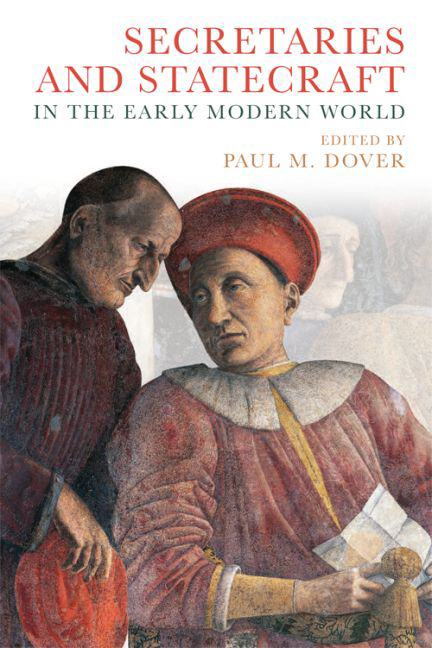Book contents
- Frontmatter
- Contents
- List of Contributors
- 1 Introduction: The Age of Secretaries
- 2 Records, Politics and Diplomacy: Secretaries and Chanceries in Renaissance Italy (1350–c. 1520)
- 3 Mercurino di Gattinara (1465–1530): Imperial Chancellor, Strategist of Empire
- 4 ‘This continuous writing’: The Paper Chancellery of Bernhard Cles
- 5 Parables and Dark Sentences: The Correspondence of Sir William Cecil and William Maitland (1559–73)
- 6 Axel Oxenstierna and Swedish Diplomacy in the Seventeenth Century
- 7 Statecraft and the Role of the Diplomat in Ducal Savoy: The Career of Alessandro Scaglia (1592–1641)
- 8 Richelieu, Mazarin and Italy (1635–59): Statesmanship in Context
- 9 The Learned Ideal of the Mughal Wazīr: The Life and Intellectual World of Prime Minister Afzal Khan Shirazi (d. 1639)
- 10 Reconsidering State and Constituency in Seventeenth-Century Safavid Iran: The Wax and Wane of the Munshi
- 11 Choreographers of Power: Grigorii Kotoshikhin, State Secretaries and the Muscovite Royal Wedding Ritual
- 12 Eberhard von Danckelman and Brandenburg's Foreign Policy (1688–97)
- 13 Chancellor of State: Prince Wenzel Anton Kaunitz, the Habsburg Foreign Office and Foreign Policy in the Era of Enlightened Absolutism
- Index
11 - Choreographers of Power: Grigorii Kotoshikhin, State Secretaries and the Muscovite Royal Wedding Ritual
Published online by Cambridge University Press: 21 November 2017
- Frontmatter
- Contents
- List of Contributors
- 1 Introduction: The Age of Secretaries
- 2 Records, Politics and Diplomacy: Secretaries and Chanceries in Renaissance Italy (1350–c. 1520)
- 3 Mercurino di Gattinara (1465–1530): Imperial Chancellor, Strategist of Empire
- 4 ‘This continuous writing’: The Paper Chancellery of Bernhard Cles
- 5 Parables and Dark Sentences: The Correspondence of Sir William Cecil and William Maitland (1559–73)
- 6 Axel Oxenstierna and Swedish Diplomacy in the Seventeenth Century
- 7 Statecraft and the Role of the Diplomat in Ducal Savoy: The Career of Alessandro Scaglia (1592–1641)
- 8 Richelieu, Mazarin and Italy (1635–59): Statesmanship in Context
- 9 The Learned Ideal of the Mughal Wazīr: The Life and Intellectual World of Prime Minister Afzal Khan Shirazi (d. 1639)
- 10 Reconsidering State and Constituency in Seventeenth-Century Safavid Iran: The Wax and Wane of the Munshi
- 11 Choreographers of Power: Grigorii Kotoshikhin, State Secretaries and the Muscovite Royal Wedding Ritual
- 12 Eberhard von Danckelman and Brandenburg's Foreign Policy (1688–97)
- 13 Chancellor of State: Prince Wenzel Anton Kaunitz, the Habsburg Foreign Office and Foreign Policy in the Era of Enlightened Absolutism
- Index
Summary
Sometime before 1 September 1664, Grigorii Karpovich Kotoshikhin, a middlelevel chancery clerk (pod'iachii) in the Russian Foreign Office (Posol'skii prikaz), fled his homeland for the West. He went first to Vilna, which was then part of the Polish–Lithuanian Commonwealth (the so-called Rzeczpospolita), then to Poland proper, and then on to Silesia, Prussia, Lübeck and, by the autumn of 1665, to Sweden. Kotoshikhin fled for several possible reasons, all of them good, though historians remain unclear which, if any, was the most important. He fled, according to one view, because he and his father had made powerful enemies at court and their property and other possessions had been (apparently unjustly) confiscated. Kotoshikhin feared additional reprisals and found escape the best alternative in his predicament. Or Kotoshikhin fled, as he himself would later claim, because he had inadvertently manoeuvred himself into the hopeless position of being a pawn in the intrigues of powerful men over him, each trying to cajole him into supporting their feud against the other. Or, what is most likely, Kotoshikhin fled his homeland and made a break for Russia's western neighbours and rivals because he had been passing secret information to the Swedes off and on since the summer of 1663 and feared that his treason was about to be discovered.
Kotoshikhin was therefore one of the earliest and most famous of Russia's defectors. But his name may not have become so well known to us were it not for the account he wrote for his new Swedish masters in the late spring and summer of 1666, in which he described ‘the whole Muscovite state’. This account, entitled On Russia in the Reign of Aleksei Mikhailovich (O Rossii v tsarstvovanie Alekseia Mikhailovicha), is a broad yet penetrating description of how seventeenth-century Muscovy was run. It is divided into thirteen thematic chapters, each treating what Kotoshikhin considered to be a key element of the Muscovite government and political culture, though he surely would not have used these terms to describe them. He begins in chapter 1 with a detailed description of the tsar's family and of important moments in the life cycle of the tsar and his kin, including a lengthy explanation of royal wedding ceremonies.
- Type
- Chapter
- Information
- Secretaries and Statecraft in the Early Modern World , pp. 235 - 253Publisher: Edinburgh University PressPrint publication year: 2016

